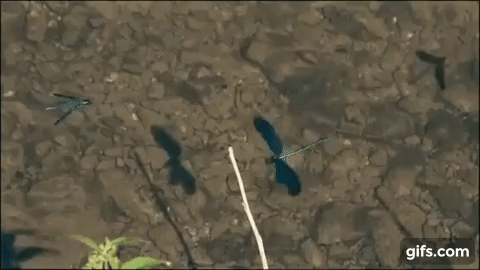
Flying insect-inspired micro-robot. Source: Harvard University
If you have watched The Matrix, you would probably agree that the evil Machines (the Sentinels) who hunt down Neo and other humans in the Real World look terrifying yet oddly familiar. That’s because, in my opinion, the creative directors based the Machines off of insects not just for the appearance but also behaviour; as you can see in Fig. 1, the Machines and cicadas bear striking resemblance, while the swarming robot army attack looks like an ant colony swarming prey. One could say that the creative directors had incredible foresight, because today, after more than a decade since the release of The Matrix, there has been significant advancement in insect-inspired robotics. From flying robots that are as small as bees to robots those that can jump over 3 metres into the air, researchers have begun applying biomechanical principles from insects to the field of robotics. Micro-robots can benefit society in numerous ways; think of the utility of small robots that can traverse dangerous terrain instead of humans for search and rescue, anti-poaching surveillance, border control, or fighting urban and natural fires. Today’s article will highlight a handful of interesting insect-inspired robotics studies, but I will only scratch the surface in this article, so I’d like to encourage further discussions in the comment section.

Fig 1. Left: A Sentinel machine from The Matrix. Right: Giant Sumatra Cicada. Sources: The Matrix, Wikipedia Commons
320 Million Years Before the Wright Brothers
Insects were the first organisms on Earth to take to the skies – estimates on the origin of insect flight range from ~320 to ~400 million years ago (mya) [1]. That is a long, long time before vertebrates achieved this feat (~200 mya). Insects have had ample time to perfect flying, and they have become true masters of speed, agility, and grace in the air. Just look at the elegant Austrophlebia costalis (southern giant darner), a dragonfly species in Australia that can fly at an incredible speed of 98 km/hr [2], the official record for fastest recorded flying insect. On top of high-speed flight, the giant darner is also capable of hovering, diving, and swerving. In addition, due to its small size and energy capacity, insect flight has to be highly optimised to maximise efficiency. How do flying insects achieve these amazing feats, and how can we translate the biological principles into engineering? This section will introduce a simplified list of concepts that need to be incorporated to translate insect flight into mechanical robotic flight, and also showcase two labs that are conducting cutting-edge research on insect-inspired micro aerial vehicles (MAVs).

Fig 2. Damselflies‘ elegant flight. Source: The Secrets of Nature
When you notice a common house fly or mosquito whizzing around you, your first impulse is to wave them away, frustrated by their onslaught for your food or blood. But what these pesky bugs are achieving in front of you is nothing short of awe-inspiring, since an insect needs to accomplish a myriad of tasks just to bother you [3]:
- Visual data processing: Identifying target and tracking it whilst flying, avoiding collision, all in real-time
- Wing muscle control: Driving one or two sets of paired wings to regulate speed and maneuverability
- Body and leg orientations: If landing or grabbing prey mid-air, or controlling an impending collision
The aforementioned components of insect flight already seem daunting, yet the list is a gross over-simplification of the complexity of flight mechanics. Researchers have been scrutinising aspects of insect flight for more than four decades, from wing aerodynamics to new materials that imitate wing membranes and how the insect brain orchestrates all the various processes. While there are currently several research labs both in academia and industry that are investigating the principles underlying insect flight and translating them into robotics, three examples are highlighted below for their cutting-edge work on MAVs.
Harvard Microrobotics Lab (Prof. Robert Wood)

Fig 3. RoboBee takes flight. Source: Harvard Microrobotics Lab
Professor Rob Wood is well known for his RoboBees, MAVs weighing as little as 60 mg with a tiny 3 cm wingspan that can hover and fly (see Fig 3). For comparison, a standard ping pong ball weighs around 2.7 g, or 45 times as much as a RoboBee. They are an incredible combination of new materials that imitate wing membranes of actual flies and bees, carbon fibre composites to provide structural support for the wings and body, and mini-actuators that can generate enough power to provide sufficient lift. Such robots hold promise for improving search and rescue operations as they can navigate small crevasses with high dexterity. Wood’s lab also works on legged robots, printable robots, and soft robotics, all with a heavy influence from insects.
Leonardo Lab (Dr. Anthony Leonardo)

Fig 4. Dragonfly catching prey mid-air (slowed down video). Source: Stacey Combs, Harvard University
While this lab hasn’t constructed microrobots just yet, their research involves using “bionic” dragonflies to study how neurons processes information, and who doesn’t want to read more about dragonflies with high-tech backpacks? The Leonardo lab uses dragonflies as a model organism to understand the pin-point precision of dragonfly prey capture (see Fig 4). Whether the dragonfly picks off a fly mid-air or off a stick, it is capable of going through the aforementioned three tasks (data processing, wing control, body and leg orientation), all at extremely fast speeds. If you want to find out more about how the tigers of the air achieve this, check out the Leonardo lab.
Festo (Private)

Fig 5. Multiple butterfly-inspired robots flying together. Source: Festo
Festo is a global large pneumatic and electrical automation technology company with a special research unit dedicated to bionics. Their website touts commercialisation-ready robots, called eMotionButterflies, BionicOpter, and BionicANTS, inspired by butterflies, dragonflies, and ants, respectively. While the details of the technology isn’t available to the public, their promotional videos hint at highly complex flying behaviour (see Fig 5 and links). They also offer student internships and dissertation projects, so are worth checking out for students interested in pursuing robotics research and development in industry.
Jump! Might As Well, Jump (cue Van Halen)

We’ve so far explored flight, an enormously complex skill that is yet so common amongst insects. Another stunning ability of insects is their powerful jump. Perhaps the most renowned champion jumper is the flea, and many people have heard the phrase “the flea can jump over 100 times its body length.” [4]. Indeed, the flea has inspired several robots, and one recent example will be covered in this section. There are numerous other jumping insects that have inspired researchers, so an additional jumping species will be highlighted – the desert locust. Developing a better understanding of the principles governing jumping is important as jumping (combined with gliding) allows for more efficient coverage of area compared to walking or even running, with potential applications in missions for the military, search and rescue, and extra-planetary exploration.
For fleas and locusts, the principal means of escaping danger is to rapidly execute a jump. Using the energy output for one jump of a flea and the time it takes to jump, one can estimate the necessary power output for the legs [5]. And this is where it gets interesting – the required output is much too high for a simple contraction of the leg muscles. Therefore, to achieve their powerful jumps, these insects have engineered themselves to store and amplify large amounts of potential energy that can be transferred to a jump. In fleas, an elastomer called resilin is the storage reservoir, whereas for locusts it is the semi-lunar process (both materials are toughened pieces of elastic cuticle) [6]. The insect does work to compress or bend these materials, and with the help of a locking system, stores that energy until just the right moment, at which point the energy is rapidly released and the insect is thrust into the air. This biological process of energy storage → locking → sudden release is analogous to a spring catapult, where the spring is compressed (storage) → latch locks the gear (locking) → sudden release of the lock catapults the object. The BioRobotics Laboratory at Seoul National University has built a micro-robot inspired by the flea’s jumping mechanism (see Fig 6). Their larger robot, which is 3 cm in length and weighs just over 2 g, can jump 120 cm vertically [7]. The researchers employed an innovative folding approach, where the robot 3D structure was made from a 2D planar body design, and utilised flea-inspired energy storage and catapult system to achieve such impressive jumping feats.

Fig 6. Flea robot jumping, recorded at 1500 frames per second. Source: Seoul National University
While the flea robot above can jump vertically, the locust-inspired TAUB robot (Tel-Aviv University & Braude College) can reach an incredible 335 cm vertically and 137 cm horizontally [6] (Fig 7). As described above, locusts store energy in the semi-lunar process (and their large leg muscles), and the researchers implemented this in TAUB using springs to generate the impressive jumping profiles (Fig 8).

Fig 7. Locust-inspired jumping robot. Source: [6]

Fig 8. The TAUB robot in action. Source: [6]
As the various flying and jumping robots illustrate,such leaps and bounds in robotics would not have been feasible without the translation of biomechanical principles into engineering and technology. That is why understanding how insects function is important for scientific and technological advancements – these critters inspire us to push our boundaries further with their amazing feats.
P.S. Shoutouts to other incredible insect-inspired robots that didn’t make it to the main article:
- Jesus robot (aka water strider robot)
- If you thought insects only jumped off of the ground, then you’d be pleasantly surprised that water striders can jump from the surface of the water, and that scientists have created a robot strider
- Cockroach robot (aka your worst nightmare but amazing for search & rescue)
- Courtesy of the Rob Full lab at UC Berkeley, here is a robot cockroach
- An insect-robot swarm (aka The Matrix is going to happen in real life)
- A thousand-strong swarm of micro-robots that can communicate with each other to form complex arrangements. What could go wrong?
- Rice grain-sized robots (aka oops where did I drop it?)
- Tiny robots (4 mm!) that can jump. Prof. Bergbreiter’s lab uses combination of soft and hard materials to create robots at this scale
References
- Misof, B. et al. Phylogenomics resolves the timing and pattern of insect evolution. Science 346, 763–7 (2014).
- Tillyard, R.J. The biology of dragonflies. Cambridge, University Press (1917).
- Floreano, D., Srinivasan, M. V., Zufferey, J. C. & Ellington, C. Flying insects and robots. Fly. Insects Robot. 1–316 (2010). doi:10.1007/978-3-540-89393-6.
- Noh, M., Kim, S. & Cho, K. J. A Miniature Jumping Robot with Flea-inspired Catapult System: Active Latch and Trigger. Int. Work. Bio-Inspired Robot. 3–5 (2011).
- Burrows, M. How fleas jump. J. Exp. Biol. 212, 2881–2883 (2009).
- Zaitsev, V. et al. A locust-inspired miniature jumping robot. Bioinspir. Biomim. 10, 66012 (2015).
- Koh, J. S., Jung, S. P., Noh, M., Kim, S. W. & Cho, K. J. Flea inspired catapult mechanism with active energy storage and release for small scale jumping robot. Robotics and Automation (ICRA), 2013 IEEE International Conference on 26–31 (2013). doi:10.1109/ICRA.2013.6630552



